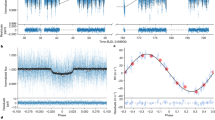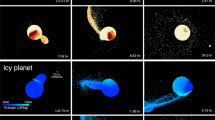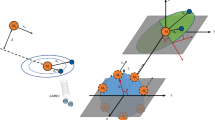Abstract
ALL planets and satellites are generally believed to have formed by accretion of small bodies. The craters on the Moon, Mercury and Mars give clear evidence that the accretion of small bodies was of major importance, at least during the last phase of their formation. It is very likely that collision and fragmentation of planetesimals played a key part in the accretionary stage of planets. As suggested by Hartung1, accumulation and fragmentation of planetesimals may have competed in the planetary accretion process, and a planetesimal which could survive catastrophic destruction may have become a planet. On the basis of the accretion model of planet formation, we propose a new idea in which we explain why minor planets are ‘minor’ and could not grow to a full-size planet. These results also substantiate Orowan's2 idea that terrestrial planets accreted inhomogeneously, with iron being the first to accumulate and silicates the second.
This is a preview of subscription content, access via your institution
Access options
Subscribe to this journal
Receive 51 print issues and online access
$199.00 per year
only $3.90 per issue
Buy this article
- Purchase on Springer Link
- Instant access to full article PDF
Prices may be subject to local taxes which are calculated during checkout
Similar content being viewed by others
References
Hartung, J. B. Lunar Science 6, 337–339 (The Lunar Science Institute, Houston, 1975).
Orowan, E. Nature 222, 867 (1969).
Matsui, T. thesis, Univ. Tokyo (1976).
Remo, J. L. & Johnson, A. A. J. geophys. Res. 80, 3744–3748 (1975).
Hahn, G. T., Averbach, B. L., Owen, W. S. & Cohen, M. in Fracture (eds Averbach, B. L., Felback, D. K., Hahn, G. T., & Thomas, D. A.) 91–116 (MIT Press, Cambridge, 1959).
Gault, D. E. & Wedekind, J. A. J. geophys. Res. 74, 6780–6794 (1969).
Fujiwara, A., Kamimoto, G. & Tsukamoto, A. Icarus 31, 277–288 (1977).
Hartmann, W. K. Lunar Science 8, 403–405 (The Lunar Science Institute Houston, 1977).
Lewis, J. S. Science 186, 440–443 (1974).
Author information
Authors and Affiliations
Rights and permissions
About this article
Cite this article
MATSUI, T., MIZUTANI, H. Why is a minor planet minor?. Nature 270, 506–507 (1977). https://doi.org/10.1038/270506a0
Received:
Accepted:
Issue Date:
DOI: https://doi.org/10.1038/270506a0
This article is cited by
-
Fragmentation of the universe
Astrophysics and Space Science (1983)
-
Experiment on the clustering of fine particles
Astrophysics and Space Science (1979)
Comments
By submitting a comment you agree to abide by our Terms and Community Guidelines. If you find something abusive or that does not comply with our terms or guidelines please flag it as inappropriate.



